Softboxes are great for portraits and other types of photography where you need soft lighting. But there is something else that you could use with a softbox to accentuate the results: grids. They come in all shapes and sizes, and you are likely to find one that matches your softbox. Grids do something that is impossible to achieve with just a stand-alone softbox: they create directional lighting. In this video, photographer Gavin Hoey shows exactly how grids can make a huge difference in your photography:
How do grids create directional light?
Grids stop the light from spilling out of the edges of the softbox. To demonstrate this, Hoey turned a softbox with a grid mounted on it away from the camera. The more he turned it away, the more the grids cut the angle of the light.

Gridded Softbox
Are there are downsides to using grids?
Yes, there are a few downsides to using grids. First, grids are not standard accessories—you might need to purchase them separately from the softbox. Second, grids will stop some amount of light and even the slightest bit of turning the softbox will bear some effect on the exposure. This is why it is a good idea to keep checking the flash exposure after each adjustment and increase it to compensate for any loss of light. A light meter can be a very handy tool in these circumstances.
How does a grid affect the image?

Shot with the grid on. Softbox positioned at camera right.
As you can see in the image above with the grid on, the light is directional yet soft. However, a lot of the light is actually stopped, which is why the background (white) appears very dark. In the next image Hoey removed the grid. Here you can see more of the light reached the background, which is why it has a slight grey but uniform tone.

Same shot without the grid
In the above two images, Hoey left a lot of space between the model and the background. In the next few images, the model leaned against the wall. The first image (below) was taken using 1/160 of a second, f/5.6 at ISO 100. Hoey took this without the grid. As you can see, the light is very soft but it has also spilled everywhere. This is what you get without the grid.

Model against the wall, shot with the grid off
With the grid on, Hoey got a lot more directional light, however he also lost one stop of light. The light meter read f/4 against f/5.6 in the previous shot. The choice was either to shoot at f/4 or bump up the amount of light by one stop, which is what Hoey did in this case.

Same shot but now with the grid on
As you can see the light is again very directional but yet retains the softness.
In the next attempt, Hoey used a completely different approach. He positioned the light right up against the model’s face. Without the grid, the soft light just spills to every corner of the frame.

Softbox without the grids placed close to the subject
But with the grid on, the light is again predictably directional and much more dynamic. Check out the cool drop off effect.

Similar composition but with the grid on
So, which do you prefer? With or without the grid?
Like This Article?
Don't Miss The Next One!
Join over 100,000 photographers of all experience levels who receive our free photography tips and articles to stay current:






A very informative and enlightening article. Thank you so much for posting.
I was wondering how to do this! Thanks so much, it will really help.
many secrets! thanks a lot